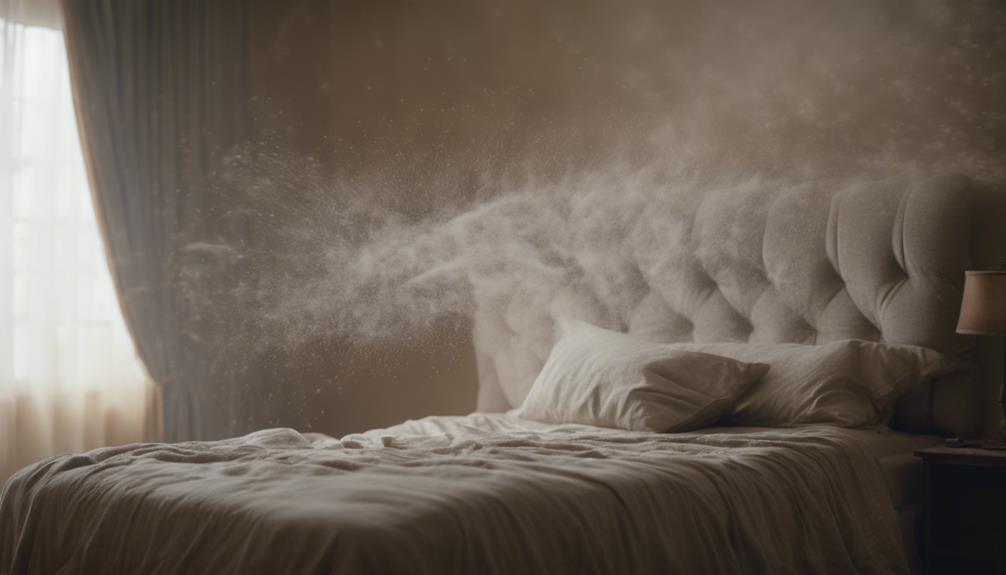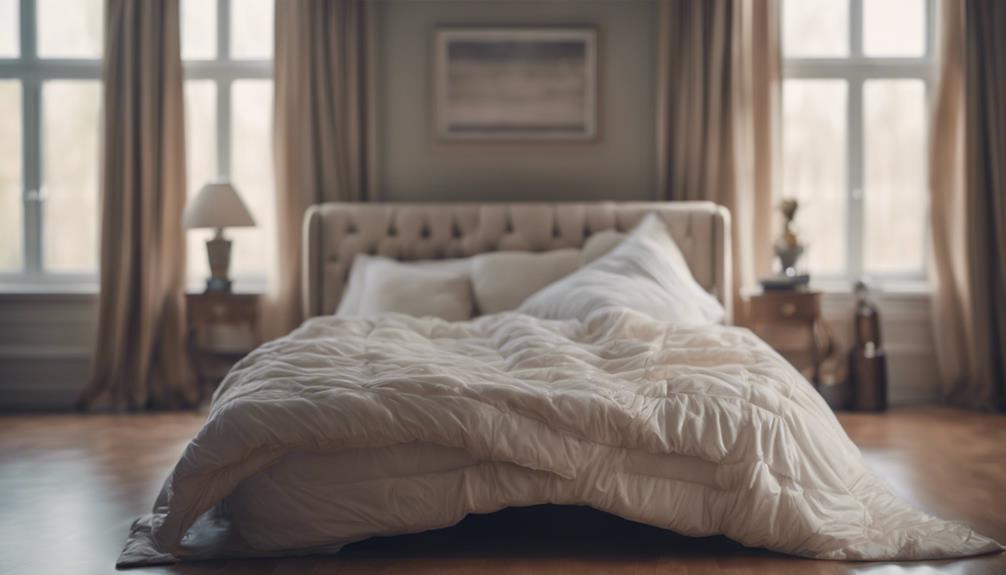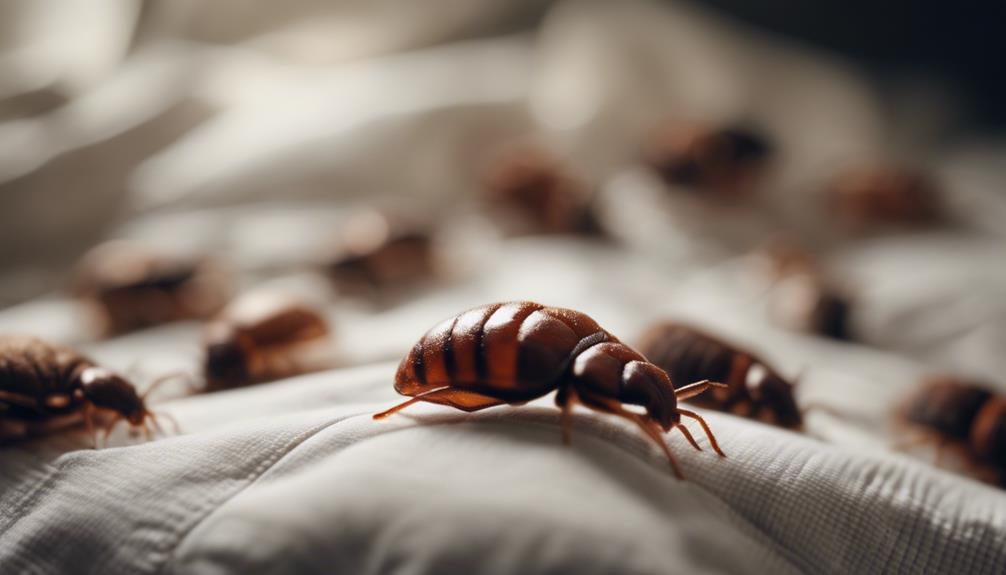Yes, examining down comforters can result in dust accumulation as they age and attract dust mites. Over time, comforters release more dust and allergens, which can potentially trigger allergic reactions. Regular maintenance such as shaking and using covers can help minimize dust exposure. Choosing high-quality construction and allergen-proof covers can also reduce dust leakage. Proper care, washing, and vacuuming are crucial in effectively managing dust and allergens. Consider alternatives like microfiber or bamboo fill for their dust-reducing benefits. Understanding the proper care and maintenance techniques can greatly impact the longevity and cleanliness of your down comforter while also maintaining air quality.
Key Takeaways
- Aging down comforters release more dust and allergens due to material breakdown.
- Dust mites attracted to down comforters contribute to dust accumulation.
- Regular cleaning and maintenance can help eliminate dust mites and allergens.
- Proper care and washing are essential to reduce allergens from down comforters.
- High-quality construction and allergen-proof covers minimize dust generation.
Impact of Down Comforter Aging
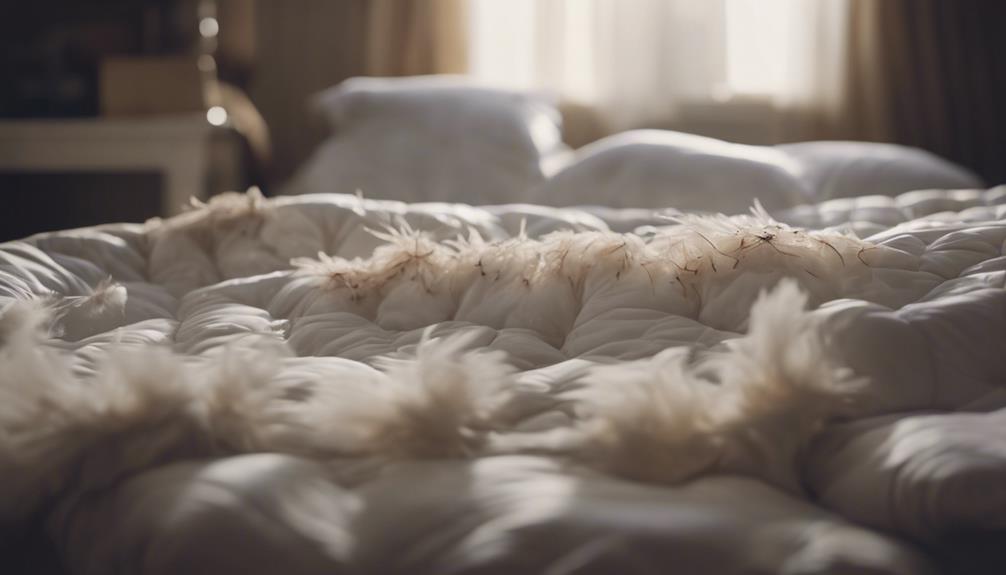
As down comforters age, they may begin to release more dust and allergens into the bedroom. This dust can contain various particles, including dust mites, which are microscopic organisms that thrive in warm and humid environments. When these dust mites are released from aging down comforters, they can trigger allergic reactions in sensitive individuals. Allergic reactions may manifest as sneezing, coughing, watery eyes, and even asthma symptoms.
It's important to note that regular use and washing of down comforters can contribute to the breakdown of the material, leading to an increase in dust release over time.
To minimize the impact of aging on down comforters, proper care and maintenance are essential. This includes following manufacturer's instructions for washing and drying, as well as regularly fluffing and airing out the comforter. By taking these precautions, you can help reduce the amount of dust and allergens that are emitted as down comforters age, creating a healthier sleeping environment for you and your family.
Dust Generation in Down Comforters

How does dust generation in down comforters impact air quality and allergies in the bedroom?
Dust in down comforters can affect the quality of air and exacerbate allergies due to the particles released. To mitigate these effects, consider the following:
- Regular Maintenance: Shaking, fluffing, and airing out your down comforter can help reduce dust generation and accumulation, promoting a cleaner sleeping environment.
- Cover Up: Using pillow cases or duvet covers can act as a barrier, containing down particles and preventing dust emission, thereby aiding in maintaining air quality.
- Beware of Dust Mites: Dust mites are often attracted to down comforters, contributing to dust accumulation. Taking care to wash your bedding regularly can help eliminate these allergens.
- Take Care: Proper care and maintenance of your down comforter, including following washing instructions and using allergen-proof covers, can go a long way in minimizing dust generation and its impact on allergies.
Allergies and Down Comforters

Discussing allergies and down comforters, the presence of dust mites and allergens within these bedding items can lead to potential allergic reactions and discomfort for individuals sensitive to such particles. Dust mites present in down comforters can trigger symptoms such as itching in the eyes and throat, especially for those with down allergies. These allergens may exacerbate existing respiratory conditions or cause new allergic reactions in individuals.
To alleviate these issues, proper care and maintenance of down comforters are essential. Regular cleaning, such as washing the comforter in hot water or using a damp cloth to wipe it down, can help reduce the accumulation of dust mites and allergens. For those with severe allergies, considering alternative bedding options made from synthetic materials may be a suitable choice.
It's important to prioritize cleanliness and allergen control in bedding to create a more comfortable sleeping environment, especially for individuals prone to pet allergies or the last one in the family to develop allergic reactions.
Proper Care for Down Comforters

Regular washing and proper care of down comforters play an important role in reducing the accumulation of dust and allergens. To guarantee your down comforter remains fresh and free of dust-related issues, follow these essential care tips:
- Follow Manufacturer's Instructions: Always adhere to the care guidelines provided by the manufacturer. Using a duvet cover can prevent dust from escaping the comforter and help maintain cleanliness.
- Choose High-Quality Construction: Opt for down comforters with tightly woven covers and high-quality construction. These are less likely to leak dust particles, keeping your sleeping environment cleaner.
- Vacuum and Air Out Periodically: Regularly vacuuming your down comforter and airing it out can help eliminate any dust buildup. This simple maintenance routine can contribute to a fresher and more allergen-free sleep space.
- Invest in Hypoallergenic Materials: Consider investing in a down comforter made with hypoallergenic materials. These comforters are designed to minimize the risk of dust-related issues, offering a healthier and more comfortable sleeping experience.
Quality Vs. Dust-Leaking Comforters

When choosing a down comforter, opt for high-quality options with tightly woven fabric covers to minimize dust leakage. Consider using allergen-proof covers or duvet covers to further prevent dust accumulation.
Investing in reputable brands can provide long-term benefits by reducing the risk of dust leaking from your comforter.
Dust-Proof Comforter Materials
High-quality down comforters with tightly woven fabric covers are effective in minimizing dust leakage. When considering dust-proof comforter materials, it's crucial to prioritize quality to reduce potential allergens in your sleeping environment.
Here are four key points to keep in mind:
- Opt for down comforters from reputable brands known for their quality craftsmanship.
- Regular maintenance and proper care, like fluffing and airing out your comforter, can help prevent dust accumulation.
- Consider investing in a dust-proof cover specifically designed for down comforters to provide an extra layer of protection.
- Be mindful of the construction and materials used in your comforter to make sure it's less likely to leak dust particles into the air you breathe.
Anti-Allergen Comforter Options
In selecting anti-allergen comforter options, we prioritize effectiveness in preventing dust leakage while maintaining quality standards. When considering anti-allergen comforters, it's essential to choose high-quality options that offer both superior protection against dust and long-lasting comfort. To help you make an informed decision, we've compiled a comparison table highlighting key features of various anti-allergen comforter options:
| Comforter Option | Dust Leakage Prevention | Quality Standards |
|---|---|---|
| Premium Down Comforter | High | Excellent |
| Dust-Proof Cover Comforter | Moderate | Good |
| Hypoallergenic Synthetic Comforter | Low | Varies |
| Allergy-Friendly Wool Comforter | Moderate | High |
| Anti-Allergen Silk Comforter | Low | Superior |
Choose the option that best suits your preferences for a comfortable and allergen-free sleep environment.
Dust Levels in Down Bedding
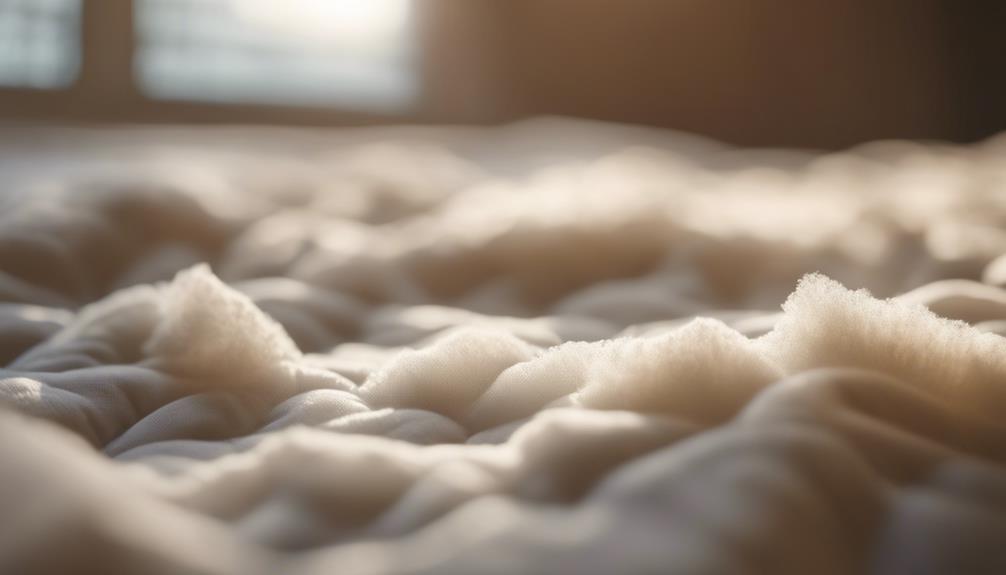
When evaluating dust levels in down bedding, it's crucial to grasp how different variables can impact the amount of dust present. Here are four key points to keep in mind:
- Down Quality: The quality of the down used in bedding can influence dust levels. Higher quality down often undergoes more rigorous cleaning processes, resulting in lower dust accumulation within the bedding.
- Environmental Cleanliness: The cleanliness of the environment where the bedding is stored and used plays a significant role in dust levels. Regular cleaning of the bedroom and proper storage of the bedding can help reduce dust accumulation.
- Maintenance Practices: Regular cleaning and upkeep of down comforters, such as washing according to care instructions, can help minimize dust levels and keep the bedding fresh and clean.
- Protective Measures: Using allergen-proof covers and following proper care techniques can further reduce dust accumulation in down bedding, helping to alleviate potential dust-related concerns.
Dust Sensitivity and Down Comforters

We must acknowledge that dust sensitivity can be exacerbated by the presence of dust mites and allergens in down comforters.
Regularly cleaning and maintaining our down bedding is vital in reducing the accumulation of dust particles.
Using a duvet cover as a protective barrier can help prevent dust from escaping the comforter.
Dust Allergies and Comforters
Regular maintenance and using allergen-proof covers can help individuals with dust sensitivities mitigate potential allergic reactions triggered by dust mites in down comforters. Dust allergies can be bothersome, but with proper care, you can enjoy the comfort of a down comforter without the discomfort of allergies. Here are four essential tips for managing dust allergies in relation to down comforters:
- Regular Cleaning: Wash and dry your down comforter frequently to reduce dust mites and allergen buildup.
- Allergen-Proof Covers: Invest in covers specifically designed to block dust mites and particles from entering or exiting your comforter.
- Hypoallergenic Options: Consider hypoallergenic bedding alternatives if dust allergies persist.
- Maintenance Routine: Establish a consistent cleaning routine to keep your sleeping environment free of dust and allergens.
Cleaning Down Bedding
To effectively maintain cleanliness and reduce dust exposure in down bedding, regular cleaning and proper care practices are essential. Begin by following the manufacturer's care instructions for washing your down comforter. Use a large capacity washing machine and mild detergent to clean the comforter thoroughly.
It's important to dry the comforter completely to prevent mold growth, which can exacerbate dust-related allergies. Consider using a duvet cover to protect the comforter from dust accumulation between washings. Additionally, vacuuming the surrounding area regularly can help minimize dust particles in the bedroom.
Dust-Reducing Alternatives to Down

Considering those with dust allergies, exploring synthetic down alternatives for bedding may be a practical solution. Synthetic down options offer a dust-reducing advantage compared to traditional down comforters. Here are four alternatives to down bedding that can help minimize dust accumulation:
- Microfiber Fill: Opt for comforters filled with microfiber, a synthetic material that resists dust mites and allergens, keeping your bedding cleaner and more hypoallergenic.
- Polyester Fill: Polyester-filled comforters are another great alternative, as polyester fibers are less likely to attract and retain dust particles, making them a suitable choice for those sensitive to dust.
- Bamboo Fill: Bamboo-filled comforters aren't only eco-friendly but also naturally hypoallergenic and resistant to dust, offering a breathable and dust-repelling bedding option.
- Silk Fill: Silk-filled comforters are luxurious and naturally hypoallergenic, making them an excellent choice for individuals looking to minimize dust exposure while enjoying a soft and comfortable bedding experience.
Health Risks of Dust From Down

When sleeping under down comforters, individuals may unknowingly expose themselves to health risks associated with inhaling dust particles released from the breakdown of feathers. These tiny particles can trigger allergic reactions, particularly in sensitive individuals, leading to symptoms such as sneezing, coughing, and watery eyes.
Additionally, dust mites, common allergens, may inhabit down comforters, further contributing to allergen exposure and potential health issues. To mitigate these risks, it's essential to regularly wash and maintain down comforters to minimize dust accumulation. Utilizing allergen-proof covers or encasing the down comforters can also help reduce the spread of dust and allergens, creating a healthier sleeping environment.
Cleaning Strategies for Down Bedding

To maintain the cleanliness and longevity of down bedding, it's essential to regularly wash down comforters following care instructions.
Proper drying techniques for down bedding, such as using low heat and fluffing periodically, can help retain its quality.
Additionally, storing down bedding in a breathable container or bag when not in use can prevent dust accumulation and maintain its freshness.
Washing Down Comforters
Regularly washing down comforters is crucial for reducing dust accumulation and allergens while maintaining their quality. To guarantee effective cleaning and care for your down bedding, follow these guidelines:
- Use Gentle Detergents: Opt for mild detergents specifically designed for down products to avoid damaging the delicate feathers.
- Wash in Large Capacity Machines: Choose a washing machine with a large capacity to allow the comforter to move freely for thorough cleaning.
- Follow Manufacturer's Instructions: Always adhere to the care instructions provided by the manufacturer to prevent any potential damage during the washing process.
- Air Dry in Sunlight: After washing, air dry the comforter in sunlight to help eliminate moisture and deter dust mites.
Drying Techniques for Down
Utilizing proper drying techniques is essential for maintaining the quality and fluffiness of down bedding. When drying down comforters, use a large capacity dryer on low heat with dryer balls to evenly fluff the down. Air drying outdoors on a sunny day can also help preserve the bedding's quality. However, it's important to avoid high heat settings and direct sunlight to prevent feather damage. During the drying process, remember to regularly fluff and shake the comforter for thorough drying. For added effectiveness, consider using tennis balls or clean sneakers in the dryer to break up clumps and restore loft to the down bedding.
| Drying Techniques for Down | ||
|---|---|---|
| Use large capacity dryer | Dry on low heat with dryer balls | Fluff down evenly |
| Air dry outdoors | Avoid high heat and direct sunlight | Preserve quality |
| Regularly fluff and shake | Ensure thorough and even drying | Maintain fluffiness |
| Utilize tennis balls or sneakers | Break up clumps and restore loft | Enhance bedding quality |
Storage Tips for Bedding
Storing down bedding in breathable cotton or linen bags is crucial to prevent dust accumulation. Avoid using plastic bags for storage, as they can trap moisture and lead to mold growth. To keep your bedding fresh and dust-free, regularly air it out in a well-ventilated space. Consider using vacuum storage bags with air-tight seals to compress the bedding efficiently while minimizing dust exposure. Additionally, store your down bedding in a cool, dry area away from direct sunlight to maintain its quality and reduce the risk of dust buildup. By following these storage tips, you can prolong the lifespan of your bedding and maintain a clean and cozy sleep environment.
- Use breathable cotton or linen bags for storage.
- Avoid plastic bags to prevent moisture retention.
- Air out bedding in a well-ventilated space regularly.
- Consider vacuum storage bags for efficient storage and minimal dust exposure.
Frequently Asked Questions
Do Down Comforters Collect Dust Mites?
Yes, down comforters can collect dust mites. These microscopic organisms thrive in warm, humid environments and feed on dead skin cells shed by humans. Regular washing and using allergen-proof covers can help reduce dust mites.
Individuals with dust mite allergies may experience symptoms like sneezing and coughing. It's essential to maintain down comforters to minimize dust mite accumulation and potential allergic reactions.
Are Down Duvets Bad for Dust Allergies?
Down duvets can exacerbate dust allergies due to the presence of dust mites in their warm, humid environment. Those with dust allergies may experience symptoms like sneezing and nasal congestion.
To minimize allergic reactions, regular cleaning and maintenance of down duvets are essential. For individuals sensitive to dust, hypoallergenic bedding options such as synthetic materials or allergen-proof covers may be more suitable than down duvets.
How Do You Clean Down Comforter Dust Mites?
To clean down comforter dust mites effectively, start by washing the comforter in hot water with a high-quality allergen-removing detergent. Thoroughly dry the comforter at high heat to eliminate dust mites.
Vacuum the area around the bed to prevent dust mites from returning. Regular cleaning helps reduce allergens and keeps your down comforter fresh and cozy.
Follow these steps to maintain a clean and allergen-free sleeping environment.
When Should You Throw Out a Down Comforter?
When to throw out a down comforter depends on its condition. Signs like excessive feather leakage, dust, and allergens indicate it may be time for a replacement. Regularly check for wear and tear to assess its lifespan. Proper care, like using a duvet cover and occasional professional cleaning, can extend its usability.
Consider replacing a down comforter if it no longer provides warmth, comfort, or starts affecting your sleep quality.
Conclusion
To sum up, while down comforters can potentially contribute to dust generation over time, proper care and maintenance can help minimize this issue.
Like a gentle breeze clearing the air, regular cleaning and dust-reducing alternatives can guarantee a healthier sleeping environment for those with sensitivities.
By selecting high-quality down comforters that are designed to prevent dust leakage, individuals can enjoy the warmth and comfort of down bedding without worrying about potential health risks.
